Norway is one of the five Scandinavian nations
located in the northern
reaches of Europe. It is bordered to the east by Sweden, Finland, and
Russia. Norway measures roughly 155,000 square miles; the country is
long, narrow, and mountainous with more than 30 percent of the land
covered by forests, rivers, and lakes. The country's population of just
over 4 million people live mostly in urban areas. Norway is a
constitutional monarchy, with a parliamentary system of government; King
Harald V is the monarch; the prime minister is usually appointed from
the ranks of the majority party. Norway enjoys excellent relations with
the United States and Canada, and has been a member of NATO since 1949.

Oslo, the capital city, has in excess of 500,000 inhabitants. Its reference point is 59,55"N, as far north as Anchorage, Alaska, and Kap Farvel in Greenland. Oslo covers about 175 square miles, including 93 square miles of forest, 40 square miles of islands and 343 inland lakes. The forested areas around Oslo are mostly pine, spruce, and birch, with a forest floor of heather. Wildlife include deer, moose, hares, and lynx. Elevation ranges from 500 to 2500 feet. Though there are quite a few roads through the forest areas, not many vehicles are able to use them -- a vehicle on these roads is a rare sight. There are a few small houses and farms in the forest, mostly built in the last century. Half of the forest is state owned, and the other half is privately owned. Landowners have no right to fence a part of the forest in; in Norway everyone has the right to walk, ski, or camp on uncultivated land without the permission of the landowner.
OSLO FIRE DEPARTMENT
The Oslo Fire Department was officially organized
in 1861, and currently
protects 500,000 residents. There are eight fire stations, including a
harbor station. The department's 418 employees include 305 in the
firefighting force, 85 staff employees, and 28 in the chimney swift
section. Firefighters work in four shifts; daytime from 8 a.m. to 5
p.m., night shift from 5 p.m. to 8 a.m., and a 24-hour shift every
second weekend. Oslo's 93 square miles of forest put the department in a
unique situation compared with other capital fire departments in Europe
-- one week they have a fire in a 30-storey building in downtown Oslo,
and the next week they fight fire in the forest, far from people and
roads.
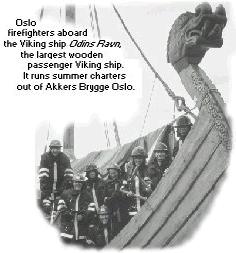
Structure firefighters -- or "smokedivers," as they're called in Norway -- are responsible for the most physically demanding work in the department. Firefighters serve as smokedivers for five to ten years and then are required to hand off the opportunity to the younger firefighters. The smokedivers serve in four special units -- Ford, Dodge, and Chevy vans -- and each unit contains five men. Two of the units specialize in smokediving and Haz-mat operations, and the other two specialize in smokediving and rescue diving.
The Haz-mat response teams are assigned to
Stations 6 and 9 and respond
to all types of Haz-mat emergencies within Oslo. The department's SCUBA
divers are firefighters trained and certified as professional divers.
Their primary responsibility is to recover drowning persons from the
Oslo Fjord and the lakes and rivers that run through Oslo City. The
divers are placed on the two smokediver/scubadiver units assigned to
Stations 1 and 3. The SCUBA divers are not limited to drowning accidents
just within Oslo; they also cover a large area around the city. This is
possible thanks to excellent cooperation with Norwegian air ambulance
and a police helicopter unit. The unit's state of readiness is very
high.
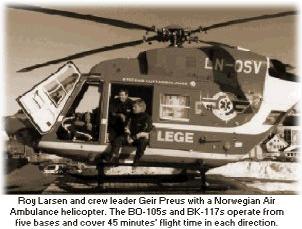
The Norwegian Air Ambulance base is located just outside Oslo; they have five bases in the country and cover 45 minutes flight time in each direction, including even a small part of Sweden. They fly BO-105 and BK-117 helicopters. The police helicopter covers a 1.5-hour flight time from Oslo in each direction, and they use a one-engine French built AS-350 B2.
All of the firefighters on the BA/scuba van are
scubadivers, but only
two of them serve as divers each shift; they change places each shift.
On one shift, a firefighter may be the driver, on the next he does BA,
and the next he does scuba -- but that does not mean that a scubadiver
does only water rescue that shift. They have all the equipment with them
that they need to do both BA or water rescue. The backs of the seats on
the BA/scuba van are turnable, with scuba gear on one side and the BA
set on the other.
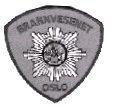
A typical scuba response with the helicopter happens like this: the alarm goes off , and the divers put on their dry suits in the station; the rest of their gear is stowed in the van and they put it on in transit. They drive to an open field not far from the station, where they meet the helicopter. One scuba diver and the leader of the vehicle take off with the copter, which now contains five persons: the pilot, a paramedic/co-pilot, a doctor, a scubadiver, and the scubadivers leader. The van, meanwhile, heads for the same destination to serve as a backup.
RESCUE AT SEA
In 1990 a terrible accident occurred when the
Scandinavian Star,
a ferry headed for Copenhagen, reported being on fire in the middle of
Swedish and Norwegian territorial waters. The fire departments closest
to the burning ship turned out and waited to be picked up by
helicopters; departments that responded included Tonsberg, Larvik, and
Sandefjord, and also the Gothenborg (Swedish) fire department. Measures
were taken to assist the ferry, but after a lot of confusing reports and
misunderstanding, the tragedy was a fact -- 158 passengers died. An
investigation committee later concluded that the safety on board ships
was not good enough and that serious steps had to be taken toward better
safety measures. The committee also concluded that Norwegian fire
departments were not well enough equipped and trained to handle a ship
fire at sea. Money was raised and today there are eight seaside fire
departments including Oslo with specialized units for rescue at sea.
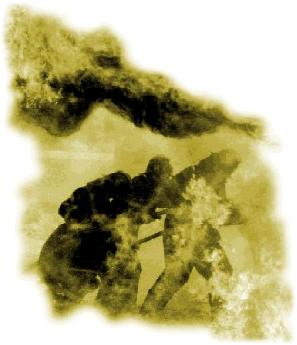
Training is organized by the National Fire and Rescue Academy, and participants learn about what will happen to a ship that takes on water, how ships are constructed, how to enter a ship in rough weather from another boat or a helicopter. There are five firefighters in each unit, and they bring with them all the equipment they need to do the job. They coordinate the response with the Air Force, the Coast Guard, and law enforcement agencies. The helicopter that takes them out to the ship is an Air Force SEA KING helicopter located in an Air Force base a few miles south of Oslo.
HEAVY RESCUE
The Oslo Fire Department heavy rescue section is another specialized rescue unit; they're responsible for emergency response to vehicle accidents and building collapses. They also handle elevator, subway, and train emergencies. Firefighters attached to the heavy rescue section are taken out of the fire force, and all their training is aimed at emergency accidents. The heavy rescue section is assigned to Station 9, the main fire station.
FIRE PREVENTION
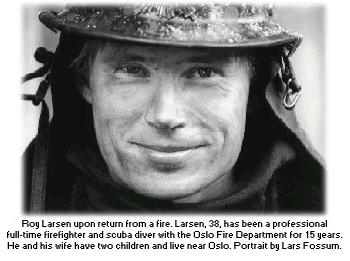
The Oslo Fire Prevention Bureau consists of one engineer and 23 officers. The bureau's responsibilities include inspection for fire-technical approval of new building constructions, Haz-mat and environment inspections, fire evaluation, and information. Inspections are conducted on hotels, schools, industrial buildings, and hospitals. Approval of new construction is done in cooperation with architects and the Department of Planning & Building. The bureau requires owners of facilities such as hotels and hospitals to maintain good internal control and documentation of safety. Chimney swifts are also attached to the fire prevention bureau; they sweep chimneys in the wintertime and do fire inspection on fireplaces in the summer.
All residences in Norway are required by law to have smoke detectors and a fire extinguisher. The Fire Prevention Bureau is expanding and will soon consist of 43 officers.
INTERNAL CONTROL
Oslo started its internal control program in 1995
to ensure that each
firefighter receives the education and training needed to function in a
professional and safe manner. Each firefighter must be able to document
the completion of a certain number of exercises in one year, from BA
training to chain saw exercises. Different levels of employment require
different exercises; for example, an officer doesn't need as many BA
exercises. Firefighters must also pass regular medical exams.
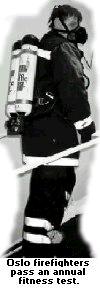
An important part of the internal control is the annual physical test, which is intended to prove that employees are fit to work as firefighters. The test involves an eight-minute walk on a treadmill with an incline of seven and a speed of 3.5 mph while wearing full turnout gear and carrying a breathing apparatus -- a total weight of 53 pounds. This treadmill test requires an oxygen intake of 40 ml per kilo bodyweight per minute, or 2.8 liters of oxygen per minute. This oxygen intake has been established by scientists in Sweden and other countries as a minimum intake for firefighters.
UNION
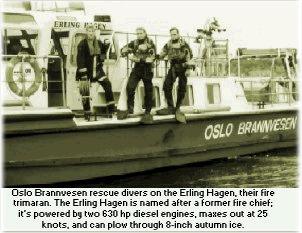
The Oslo Fire Department's union was officially
organized in 1894 and
has 100 percent participation among the fire force. The union has a good
cooperation with the other fire department unions in Scandinavia. Each
year one of the Scandinavian countries arranges a conference on "Nordic
Firefighters' Study Days," with subjects concerning firefighters' daily
work and welfare. Last year the conference was held in Iceland; it
lasted one week, and 120 Scandinavian firefighters participated. Though
the conference is arranged by the union, it is not a typical union
conference with just union topics. The topics are whatever you can think
of that concerns our daily work, and the conference is very popular
among the firefighters. The union also publishes a fire magazine which
is online at home.sol.no/~reide.
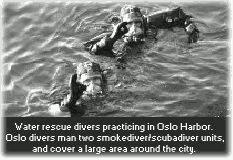
The Oslo Fire Department Sport Association organizes several sporting events for members, including Nordic and Alpine skiing, ice hockey, soccer, and handball. Department firefighters compete in both summer and wintersport events with the rest of Scandinavia. Last year's summer event was held in Gothenborg, and 300 firefighters participated.
WOMEN FIREFIGHTERS
For the first time this year, the Oslo Fire Department will include two women in the fire force. They passed a difficult physical test and will work as equals beside the men.
For more information about Norway, check out NORTRA's website at www.oslopro.no. The Oslo Fire Department doesn't yet have a website, but the Kristiansand Fire Department has one at home.sol.no/~royjaco/firenor2.htm.
The Viking ship Odins Ravn is online at www.riksnett.no/galleri/vcruise/.